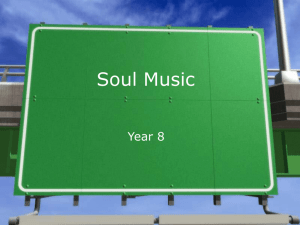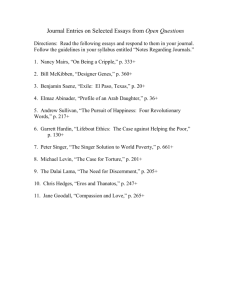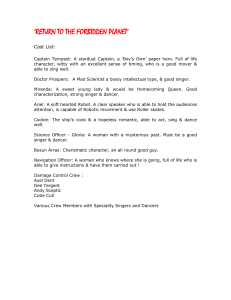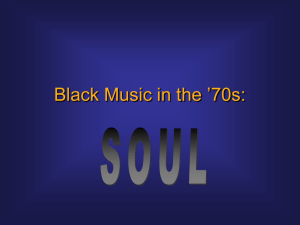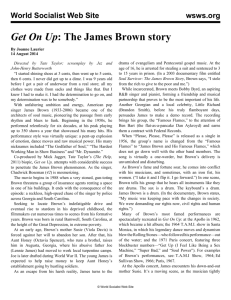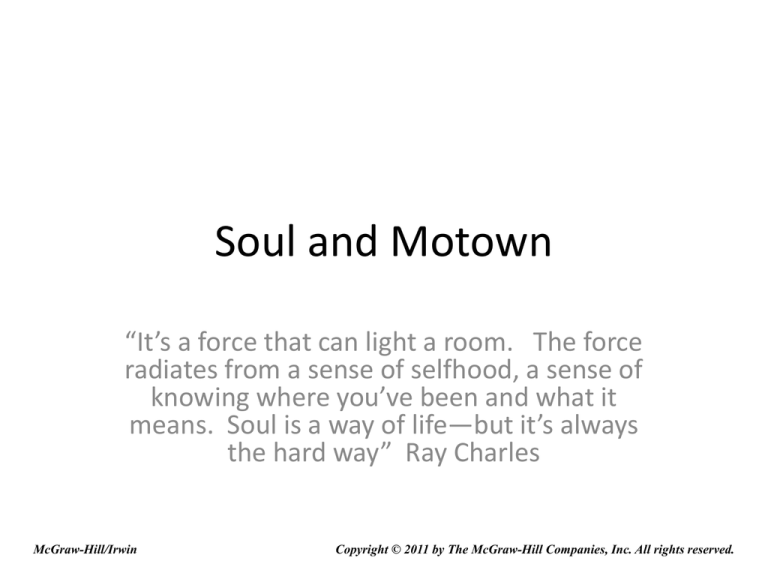
Soul and Motown
“It’s a force that can light a room. The force
radiates from a sense of selfhood, a sense of
knowing where you’ve been and what it
means. Soul is a way of life—but it’s always
the hard way” Ray Charles
McGraw-Hill/Irwin
Copyright © 2011 by The McGraw-Hill Companies, Inc. All rights reserved.
Soul
Soul developed out of Gospel
Use of melismas in solo voices
Ray Charles (1930-2004), singer, songwriter, played
keyboards and other instruments
“What’d I Say” part II included gospel style
responses and tributes to jazz greats Cab
Calloway and Pine Top Smith
Early 1960s style included influences of country
and western music
6-2
Listening Guide
“What’d I Say (Part Two)” by Ray Charles (1959)
Tempo: 180 beats per minute, 4 beats per bar
Form: Introduction is 8 bars of call-and-response
vocals as tribute to Cab Calloway
12-bar blues form follows
Features: Vocal group responds to Charles’s vocals
Piano accompanies the voice
Lyrics: Singer is thinking about sex with allusions to
dancing
Charts: Pop, #6, R&B, #1
6-3
Sam Cooke
(1935-1964), singer, songwriter
Began career as lead singer with the gospel
group the Soul Stirrers
Light, high, pop and gospel vocal style
Teen idol for black teens in early sixties
“You Send Me” first pop hit
Teen idol image shattered by violent death in
1964
6-4
James Brown
(1933-2006), singer, songwriter, inventor of musical style
Funk
Professional gospel singer
“Please, Please, Please” first pop hit
Dramatic performer with energetic dance and vocal
style
1964 - First funk recording “Out of Sight”
1968 – “Say It Loud—I’m Black and I’m Proud”
Often called the Godfather of Soul, Soul Brother No. 1,
Mr, Dynamite, The Hardest Working Man in Show
Business, and the Man with all of the Names
6-5
Listening Guide
“Please, Please, Please” by James Brown (1956)
Tempo: 74 beats per minute, 4 beats per bar
Form: Introduction with rhythmically free vocals, 8-bar periods
follow
Features: Uneven beat subdivisions
Strong backbeat in drums
Brown’s vocals include dramatic melismas and free rhythms
Doo-wop/gospel influences in backup vocals
Instruments sometimes break for solo vocals
Lyrics: The singer is begging for sex
Charts: Pop, #105, R&B, #5
6-6
Memphis Soul
Stax and Volt labels
Booker T. and the MGs
Wilson Pickett (1941-2006), singer, songwriter
Otis Redding (1941-1967), singer, songwriter
6-7
Listening Guide
“In the Midnight Hour” by Wilson Pickett (1965)
Tempo: 112 beats per minute, 4 beats per bar
Form: Section lengths vary
Features: Booker T. and the MGs, guitar, organ, bass, and drums
with horn section (trumpet and three saxophones)
Horn section plays major chords in parallel motion,
characteristic of the Memphis Soul style
Even beat subdivisions
Drums keep strong backbeat
Pickett’s vocals in gospel style
Lyrics: The singer looks forward to sex at midnight
Charts: Pop, #21, R&B, #1, British hits, #12
6-8
Atlantic Records
Ahmet Ertegun and Jerry Wexler co-producers
Aretha Franklin (born in 1942), gospel/soul
singer
Often called “Lady Soul”
6-9
Listening Guide
“Respect” by Aretha Franklin (1967)
Tempo: 112 beats per minute, 4 beats per bar
Form: 4-bar introduction, A, B, and C sections vary in length
Features: Even beat subdivisions, but some uneven in Franklin’s
vocals
Memphis horn sound with parallel chords
Active bass
Strong backbeat in drums
Tenor saxophone solo
Lyrics: The song demands for respect and satisfaction from a lover
Charts: Pop, #1 for two weeks, R&B, #1 for eight weeks, British hits,
#10
6-10
The More Commercial Style of Motown
Motown Record Co. started by Berry Gordy Jr. (born in
1929), songwriter, producer, record company owner
Most performers not formerly gospel singers
International Talent Management Incorporated,
finishing school for performers
Choreographer for vocalists
Glamorous clothing
Funk Brothers background in jazz and r&b
Performer’s stage names part of magical image (Stevie
Wonder, the Temptations, the Supremes, the
Marvelettes, the Four Tops, the Miracles)
6-11
Listening Guide
“My Girl” by the Temptations (1965)
Tempo: 112 beats per minute, 4 beats per bar
Form: Mostly 8-bar sections
Instrumental section with vocal responses
Features: Backbeat with finger snaps, then drums
Orchestral string section and brass fills
Vocal group responds to lead singer David Ruffin in
more pop than gospel style
Lyrics: The singer is fulfilled when he is with his girl
Charts: Pop, #1, R&B, #1 for six weeks
6-12
Stevie Wonder (born in 1950), singer, songwriter,
producer, keyboard and harmonica player
Motown’s first child star (age 12)
Gained production control of recordings at age
21, rare for Motown company
Michael Jackson (1958-2009), singer, songwriter,
dancer
Lead singer with the Jackson 5 at Motown
Motown’s second child star (age 10)
Marvin Gaye (1939 – 1984), singer
6-13
Listening Guide
“What’s Going On” by Marvin Gaye (1971)
Tempo: 102 beats per minute, 4 beats per bar
Form: Mostly 4-bar phrases
Features: Party-like conversation, then 4 bar instrumental before
Gaye’s vocals
Thickly arranged orchestra includes the Funk Brothers and
backup singers
Electric bass and drums part of accompaniment
Subtle backbeat played by drums and clapped by singers at
the end
Lyrics: the song is a general plea for peace and understanding in a
time of sorrow and unrest.
Charts: Pop, #2 for three weeks, R&B, #1 for five weeks
6-14
Discussion Questions
In what various ways did soul music and its
performers affect the civil rights movement?
Civil rights leaders tended to admire James
Brown much more than other great soul or
Motown artists. What are some of the likely
reasons for that?s
6-15

